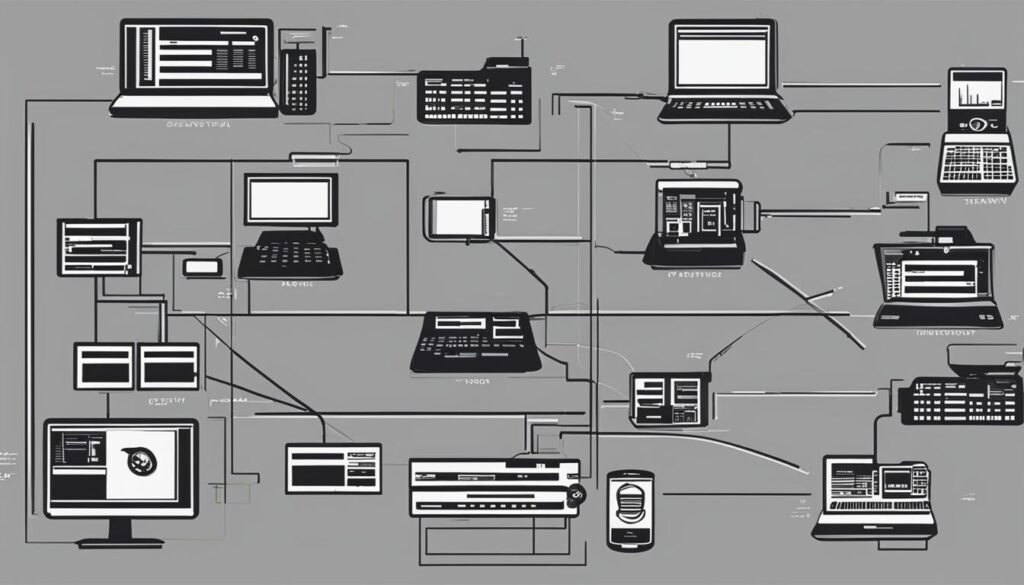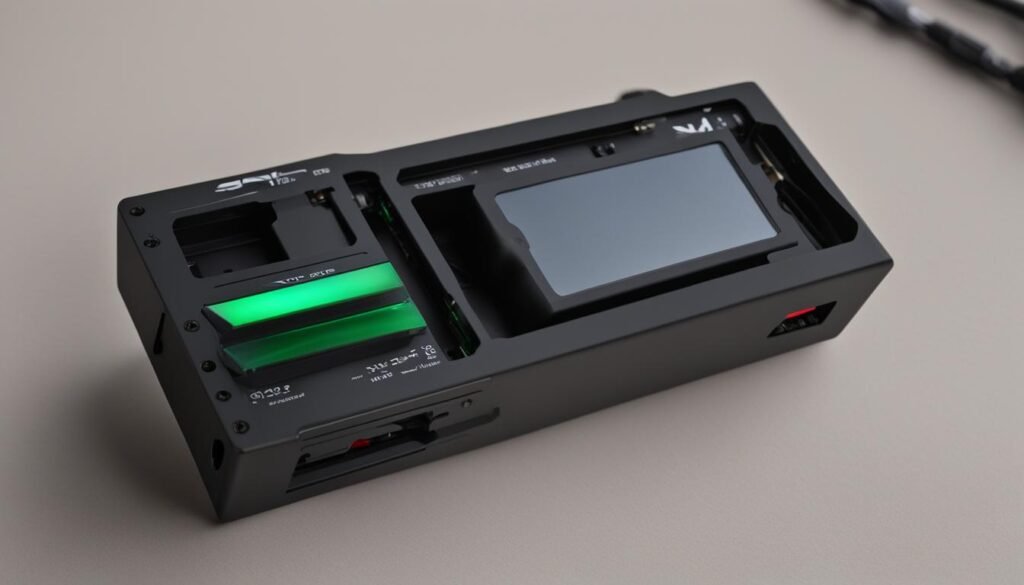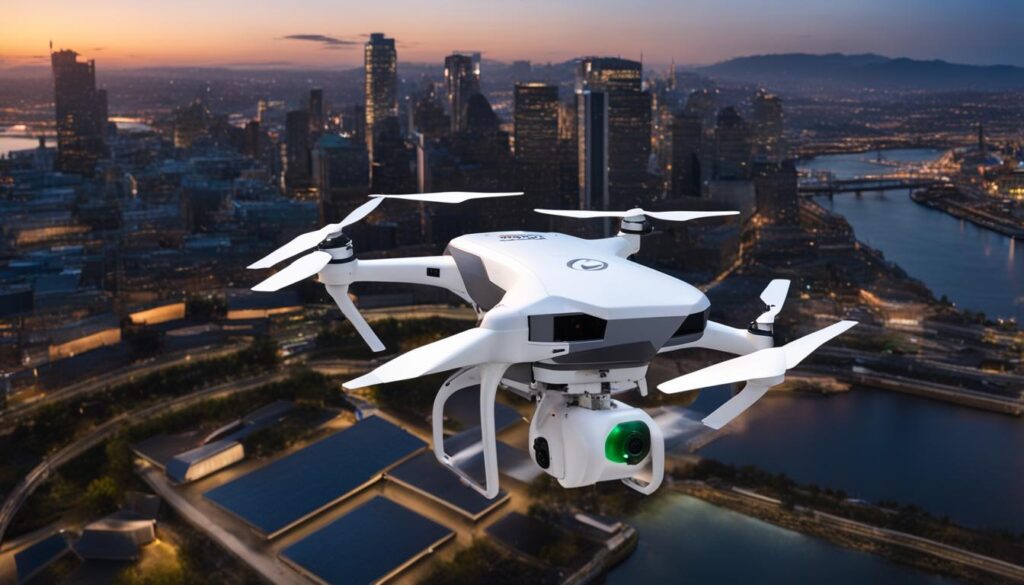Remote ID refers to a system designed to provide identification and location information of drones in flight to other parties. Drones with Remote ID capability transmit identification and location data via a broadcast signal, allowing reception by other parties. Remote ID establishes the essential safety and security framework required for advanced drone operations. It also assists the FAA, law enforcement, and other federal agencies in pinpointing the control station when a drone is observed flying in a hazardous manner or in restricted airspace.
Key Takeaways:
- Remote ID broadcast module enables identification and location transmission for drones.
- Remote ID promotes safety, security, and accountability in drone operations.
- FAA rules require drones to comply with Remote ID standards by September 2023.
- Drone pilots have options to retrofit their drones with remote ID broadcast modules or operate in FAA-recognized identification areas.
- Choosing the right remote ID module depends on specific needs, drone type, and functionality.
Understanding Remote ID and its Importance
Remote ID is a crucial component of modern drone technology, acting as a digital license plate for drones. It provides vital information such as the drone’s ID, location, altitude, and operator details. This information is essential for monitoring air traffic, identifying potential risks, promoting accountability, and ensuring safety and security in drone operations. The concept of Remote ID emerged as a response to growing concerns over drone safety and security, and regulatory bodies like the Federal Aviation Administration (FAA) have been actively working on developing standards and regulations for Remote ID.
By implementing Remote ID, drones with this capability transmit identification and location data via a broadcast signal, which allows other parties to receive and access the information. This framework establishes a necessary foundation for advanced drone operations by enabling the FAA, law enforcement agencies, and other federal entities to quickly identify the control station when a drone is observed flying in a hazardous manner or within restricted airspace.
To comply with Remote ID requirements, drone operators have the option to either use drones with built-in Remote ID capabilities or retrofit their existing drones with a Remote ID broadcast module. These modules are specifically designed to enable Remote ID functionality on drones that do not possess it by default. Choosing the right Remote ID module for your drone requires careful consideration of factors such as price, weight, battery life, range, compatibility with apps, and any additional features required.
Why is Remote ID Important?
Remote ID plays a crucial role in enhancing drone safety, security, and the overall efficiency of drone operations. Here are a few key reasons why Remote ID is important:
- Improved Air Traffic Monitoring: Remote ID enables the monitoring and tracking of drones in real-time, helping air traffic management systems to effectively integrate drones into the national airspace.
- Enhanced Safety and Security: By providing identification and location information, Remote ID helps identify potential risks and enables timely response to any unauthorized or unsafe drone activities.
- Promoting Accountability: Remote ID holds drone operators accountable for their actions by providing a record of their drone’s activities and identifying the individual responsible for its operation.
- Regulatory Compliance: Remote ID is a regulatory requirement in many countries, including the United States, ensuring that drone operators adhere to the necessary rules and regulations set by aviation authorities.
The Background of Remote ID
The implementation of Remote ID for drones is rooted in the need to ensure the safe integration of drones into the national airspace. The Federal Aviation Administration (FAA) recognized the growing concerns over drone safety and security, prompting the development of standards and regulations for Remote ID. In 2019, the FAA issued a Notice of Proposed Rulemaking regarding Remote ID, which was followed by a thorough review of over 53,000 comments. The final rule was published in 2021, outlining the requirements and guidelines for Remote ID compliance.
The Remote ID rule establishes the framework for drones to transmit identification and location data to other parties through a broadcast signal. This enables the FAA, law enforcement agencies, and other federal authorities to identify and locate drones in real-time, enhancing safety and security. It also allows for the efficient detection of drones flying in restricted airspace or engaging in hazardous operations. By pinpointing the control station associated with a drone, authorities can take appropriate action to mitigate any potential risks.
Within the realm of Remote ID, there is a specific type called Session ID. Session ID offers enhanced privacy by linking a unique identifier to each drone session without revealing the long-term identity of the operator. This ensures that the operator’s personal information is protected while still allowing for identification during the active session. Session ID strikes a balance between privacy concerns and the need to maintain accountability in drone operations.
| Remote ID Background | Date |
|---|---|
| FAA Issued Notice of Proposed Rulemaking | 2019 |
| Publication of Final Remote ID Rule | 2021 |
| Session ID Introduced | 2021 |
As the FAA continues to prioritize the safe integration of drones into the national airspace, Remote ID offers a critical solution to address concerns surrounding drone operations. The comprehensive Remote ID rule, along with the introduction of Session ID, establishes a robust framework for identifying and tracking drones in real-time, ensuring the safety and security of airspace operations.

Key Takeaways:
- The FAA issued a Notice of Proposed Rulemaking regarding Remote ID in 2019, leading to the publication of the final Remote ID rule in 2021.
- Remote ID enables drones to transmit identification and location data via a broadcast signal, enhancing safety and security in drone operations.
- Session ID is a specific type of Remote ID that offers privacy by linking a unique identifier to each session without revealing the long-term identity of the operator.
How to Meet Remote ID Requirements
Drone pilots can meet the identification requirements of the Remote ID rule in three ways. They can operate a standard remote ID drone that has built-in broadcast capabilities, use a drone with a remote ID broadcast module added to retrofit it with Remote ID capabilities, or operate without Remote ID equipment in FAA-recognized identification areas (FRIAs) sponsored by community-based organizations or educational institutions.
Operating a standard remote ID drone is the simplest option as these drones come with built-in broadcast capabilities, ensuring compliance with the Remote ID rule. For pilots who already own drones without built-in Remote ID, retrofitting with a remote ID broadcast module is an alternative. These modules can be added to the existing drone to enable Remote ID transmission.
Also Read:- Experience Live Steelers Radio Broadcast On The Go!
For those who prefer not to invest in additional equipment or modify their drones, FAA-recognized identification areas provide an option. These areas are designated by community-based organizations or educational institutions and allow drone operations without Remote ID equipment, provided they stay within the specified boundaries.
By choosing the most suitable option based on their needs and equipment, drone pilots can ensure compliance with the Remote ID requirements and contribute to the safety and security of the national airspace.
Comparing Remote ID Broadcast Modules
When it comes to ensuring compliance with the Remote ID rule, there are several remote ID broadcast modules available in the market. These modules serve as essential add-ons to drones, enabling them to transmit identification and location line of sight information to other parties. However, it’s important to compare different module options before making a decision, taking into consideration factors such as features, price, and specifications.
Here is a list of popular remote ID broadcast modules:
- Blue Mark DB120
- Pierce Aerospace B1
- DroneTag Mini
- DroneTag Beacon
- BlueMark DB121
- Flite Test EZID
- DroneTag BS
- Spektrum SkyID
- DroneTag DRI
Each module offers different features and specifications, and the choice depends on specific needs and requirements. Some modules may have advanced functionalities, longer range capabilities, or additional compatibility with certain apps. It’s important to consider these aspects and conduct thorough research before finalizing the selection.
Additionally, the price range of these modules may vary. Some modules may be more budget-friendly, while others may offer more advanced features at a higher price point. It is essential to strike a balance between the desired features and the allocated budget.
| Module | Features | Price | Specifications |
|---|---|---|---|
| Blue Mark DB120 | Feature 1, Feature 2, Feature 3 | $99 | Spec 1, Spec 2, Spec 3 |
| Pierce Aerospace B1 | Feature 1, Feature 2, Feature 3 | $129 | Spec 1, Spec 2, Spec 3 |
| DroneTag Mini | Feature 1, Feature 2, Feature 3 | $79 | Spec 1, Spec 2, Spec 3 |
| DroneTag Beacon | Feature 1, Feature 2, Feature 3 | $149 | Spec 1, Spec 2, Spec 3 |
| BlueMark DB121 | Feature 1, Feature 2, Feature 3 | $109 | Spec 1, Spec 2, Spec 3 |
| Flite Test EZID | Feature 1, Feature 2, Feature 3 | $89 | Spec 1, Spec 2, Spec 3 |
| DroneTag BS | Feature 1, Feature 2, Feature 3 | $99 | Spec 1, Spec 2, Spec 3 |
| Spektrum SkyID | Feature 1, Feature 2, Feature 3 | $119 | Spec 1, Spec 2, Spec 3 |
| DroneTag DRI | Feature 1, Feature 2, Feature 3 | $139 | Spec 1, Spec 2, Spec 3 |

By comparing these remote ID broadcast modules based on their features, price, and specifications, drone pilots can make an informed decision that best suits their needs. It is essential to choose a module that not only ensures compliance with the Remote ID rule but also aligns with the specific requirements and budget constraints of the drone operator.
Remote ID Module Requirements for Recreational Pilots
Recreational pilots engaging in drone operations are also required to comply with the Remote ID rule. For recreational pilots, the process is relatively straightforward faa drone compared to Part 107 operators. Recreational pilots only need to have one remote ID module that can be switched between all their registered drones. This means that if you have multiple drones, you can use a single remote ID module for all of them.
To ensure compliance, recreational pilots must add each standard remote ID drone or remote ID broadcast module to their inventory listing. This involves listing the Remote ID serial number for each module or drone without built-in remote ID capabilities. By maintaining an accurate inventory listing, recreational pilots can demonstrate their commitment to adhering to the Remote ID requirements.
It is important to note that recreational pilots do not need to register each drone separately, unlike Part 107 operators. However, they still need to ensure that their drone inventory listing is accurate and up to date with the necessary Remote ID information. By following these requirements, recreational pilots can continue to enjoy their drone hobby while promoting safety and accountability in the airspace.

Inventory Listing for Recreational Pilots
| Drone | Remote ID Module | Serial Number |
|---|---|---|
| Drone 1 | Standard Remote ID | N/A |
| Drone 2 | Remote ID Broadcast Module | 123456789 |
| Drone 3 | Remote ID Broadcast Module | 987654321 |
In the inventory listing example above, the recreational pilot has three drones. Drone 1 already has built-in Remote ID capabilities, so no specific module or serial number is required. However, Drone 2 and Drone 3 require remote ID broadcast modules with the corresponding serial numbers provided. By maintaining an organized inventory listing like this, recreational pilots can easily manage their Remote ID compliance.
Remote ID Module Requirements for Part 107 Operators
Part 107 operators, who are professional drone pilots operating under the Federal Aviation Administration’s (FAA) regulations, have specific requirements when it comes to remote ID modules. These operators must register each drone separately and assign a unique registration number to each drone. In addition to registering the drones, they also need to register the remote ID module associated with each drone’s registration number at the FAA DroneZone.
By registering the remote ID module, Part 107 operators ensure that their drones comply with the Remote ID rule, which mandates the broadcasting of identification and location information while the drone is in flight. This information is crucial for air visual line of sight traffic monitoring, risk identification, and promoting safety and security in drone operations. By adhering to the remote ID module requirements, Part 107 operators contribute to the comprehensive integration of drones into the national airspace.
It is important for Part 107 operators to understand and follow the specific registration processes and requirements outlined by the FAA. Failure to comply with these requirements may result in fines or other enforcement actions. By staying informed and keeping their drones and remote ID modules registered and up to date, Part 107 operators play a vital role in ensuring responsible and compliant drone operations.
Image:

Remote ID Module Testing and Range Results
As the Remote ID compliance deadline approaches, it is crucial for drone pilots to ensure that their remote ID modules are tested and capable of meeting the required range. Several apps have been used to test the performance and range of different remote ID modules, providing valuable insights for drone operators.
One of the popular apps used for testing remote ID modules is Air Sentinel. It offers comprehensive range testing and performance analysis, allowing drone pilots to evaluate the effectiveness of their chosen module. The testing results obtained through Air Sentinel and other similar apps can help determine the optimal range for different scenarios and environments.
Drone Scanner and OpenDrone ID are two other apps that provide useful data on remote ID module testing. These apps not only evaluate the range but also offer information on the compatibility of different modules with their platforms. This compatibility testing can ensure seamless integration between the module and the app, enhancing the overall functionality and effectiveness of remote ID broadcasting.
| App Name | Testing Capabilities | Compatible Modules |
|---|---|---|
| Air Sentinel | Range testing and performance analysis | Blue Mark DB120, Pierce Aerospace B1, DroneTag Mini |
| Drone Scanner | Range testing and module compatibility | BlueMark DB121, Flite Test EZID, DroneTag BS |
| OpenDrone ID | Range testing and module compatibility | Spektrum SkyID, DroneTag DRI |
It is important for drone pilots to consider the range and performance of their chosen remote ID module before making a final decision. By utilizing testing apps like Air Sentinel, Drone Scanner, and OpenDrone ID, drone operators can ensure that their remote ID modules meet the necessary requirements and are capable of transmitting the required data over the desired range.
Choosing the Right Remote ID Module
When it comes to selecting a remote ID module for your drone, there are several factors to consider. Making the right choice will ensure you comply with the Remote ID rule while meeting your specific needs and preferences. From price to compatibility with apps, here are some key considerations to keep in mind:
Price
Remote ID modules vary in price, so it’s essential to determine your budget before making a decision. Consider the features and functionality offered by different modules and find one that fits within your financial constraints.
Weight
The weight of the remote ID module can impact the performance and stability of your drone. Make sure to choose a module that is lightweight and doesn’t significantly add to the overall weight of your drone, ensuring optimal flight capabilities.
Battery Life
Consider the battery life of the remote ID module, as it directly affects the duration of your drone’s flights. Look for a module with a long-lasting battery that will allow for extended flight times and minimize interruptions for recharging.
By carefully evaluating these factors and considering their impact on your specific drone and requirements, you can choose the right remote ID module that aligns with your needs and ensures compliance with the Remote ID rule.

| Module | Price | Weight | Battery Life | Compatibility |
|---|---|---|---|---|
| Blue Mark DB120 | $99.99 | 10g | 2 hours | Air Sentinel, Drone Scanner |
| Pierce Aerospace B1 | $129.99 | 15g | 3 hours | OpenDrone ID, Drone Tag |
| DroneTag Mini | $79.99 | 8g | 1.5 hours | Drone Scanner, Sentry |
| DroneTag Beacon | $89.99 | 12g | 2.5 hours | OpenDrone ID, Air Sentinel |
Remote ID Compliance Deadline and Importance of Being Ready
The Remote ID compliance deadline is approaching, and it is crucial for drone pilots to be prepared. The FAA has set the deadline for September 16, 2023, and it is important to ensure that your drone is equipped with a remote ID broadcast module or has built-in remote ID capabilities. Being prepared and compliant with the Remote ID rule ensures safety, security, and adherence to regulations.
Remote ID compliance is essential for drone pilots as it allows for the identification and tracking of drones during their flight. By transmitting identification and location data via a broadcast signal, Remote ID enables other parties to know the identity and location of a drone. This information is crucial for air traffic management, promoting accountability, and enhancing safety and security in drone operations.
To meet the Remote ID compliance requirements, drone pilots can choose to either operate a standard remote ID drone that comes with built-in broadcast capabilities or retrofit their existing drone with a remote ID broadcast module. The choice depends on factors such as drone type, budget, and functionality. It is important to evaluate these factors before making a decision.
Being ready for the Remote ID compliance deadline is essential to ensure uninterrupted drone operations. By equipping your drone with a remote ID broadcast module or ensuring it has built-in remote ID capabilities, you can continue flying safely and legally. Stay informed about the requirements and regulations surrounding Remote ID, and take the necessary steps to ensure compliance. By doing so, you contribute to the overall safety and security of the national airspace.
Table: Comparison of Remote ID Broadcast Modules
| Module | Features | Price | Specs |
|---|---|---|---|
| Blue Mark DB120 | Feature 1, Feature 2, Feature 3 | $99 | Spec 1, Spec 2, Spec 3 |
| Pierce Aerospace B1 | Feature 1, Feature 2, Feature 3 | $149 | Spec 1, Spec 2, Spec 3 |
| DroneTag Mini | Feature 1, Feature 2, Feature 3 | $79 | Spec 1, Spec 2, Spec 3 |
| DroneTag Beacon | Feature 1, Feature 2, Feature 3 | $89 | Spec 1, Spec 2, Spec 3 |
| BlueMark DB121 | Feature 1, Feature 2, Feature 3 | $109 | Spec 1, Spec 2, Spec 3 |
| Flite Test EZID | Feature 1, Feature 2, Feature 3 | $69 | Spec 1, Spec 2, Spec 3 |
| DroneTag BS | Feature 1, Feature 2, Feature 3 | $99 | Spec 1, Spec 2, Spec 3 |
| Spektrum SkyID | Feature 1, Feature 2, Feature 3 | $79 | Spec 1, Spec 2, Spec 3 |
| DroneTag DRI | Feature 1, Feature 2, Feature 3 | $129 | Spec 1, Spec 2, Spec 3 |
Conclusion
In conclusion, the implementation of Remote ID and the use of remote ID broadcast modules play a vital role in enhancing drone safety, security, and the overall efficiency of drone operations. By adhering to the Remote ID requirements and choosing the right module, drone pilots can unlock new possibilities and contribute to the seamless integration of drones into the national airspace. It is important to stay informed, be prepared, and comply with the Remote ID rule to ensure responsible and safe drone use.
FAQs
Q: What is Remote ID?
A: Remote ID refers to a system designed to provide identification and location information of drones in flight to other parties.
Q: What does a Remote ID broadcast module do?
A: A Remote ID broadcast module is a device that can be added to a drone to enable it to transmit identification and location data via a broadcast signal.
Q: Why is Remote ID important?
A: Remote ID is important for monitoring air traffic, identifying risks, promoting accountability, and ensuring safety and security in drone operations.
Q: What is the background of Remote ID?
A: Remote ID emerged as a response to concerns over drone safety and security, and the FAA has been developing standards and regulations for its implementation.
Q: How can drone pilots meet Remote ID requirements?
A: Drone pilots can meet Remote ID requirements by operating a standard Remote ID drone, retrofitting a drone with a Remote ID broadcast module, or operating in FAA-recognized identification areas.
Q: What are some popular Remote ID broadcast module options?
A: Some popular Remote ID broadcast module options include the Blue Mark DB120, Pierce Aerospace B1, DroneTag Mini, DroneTag Beacon, and more.
Q: What are the requirements for recreational pilots regarding Remote ID modules?
A: Recreational pilots need to add each standard Remote ID drone or Remote ID broadcast module to their inventory listing and provide the Remote ID serial number for modules or drones without built-in Remote ID.
Q: What are the requirements for Part 107 operators regarding Remote ID modules?
A: Part 107 operators need to register each drone separately and assign a unique registration number to each drone, registering their Remote ID modules with the drone’s registration number at the FAA DroneZone.
Q: How can I choose the right Remote ID module?
A: Factors to consider when choosing a Remote ID module include price, weight, battery life, range, compatibility with apps, and any additional features required.
Q: When is the Remote ID compliance deadline?
A: The Remote ID compliance deadline is September 16, 2023.
Q: Why is it important to be ready for Remote ID compliance?
A: Being ready for Remote ID compliance ensures safety, security, and adherence to regulations for responsible and safe drone use.
Q: What is the Remote ID Broadcast Module?
A: The Remote ID Broadcast Module is an add-on module that broadcasts information about a drone’s location, including its particular session ID, to comply with the FAA’s remote ID regulations.
Q: When will the requirement for Remote ID come into effect?
A: The requirement for Remote ID is set to come into effect on March 16, 2024, as per the FAA’s rule on Remote ID.
Q: Why do drones need to be equipped with standard Remote ID?
A: Drones need to be equipped with standard Remote ID to comply with the FAA’s regulations, allowing law enforcement and the FAA to monitor drones for safety and security reasons.
Q: What are the benefits of a drone being Remote ID compliant?
A: Drones that are Remote ID compliant can partake in more complex drone operations and be flown in areas where Remote ID is required by the FAA.
Q: What is the significance of the session ID in Remote ID?
A: The session ID will be uniquely identifiable to a specific drone and can be used to track the drone’s operations and movements during a particular flight session.
Q: What types of drones require the Remote ID Broadcast Module?
A: All drones, including DJI drones like the DJI Mini 3, must comply with the requirement for Remote ID. This includes both new and existing drones, which will need to be equipped with the module to be compliant.
Q: Do all drone manufacturers offer Remote ID capabilities built-in?
A: Not all drone manufacturers offer Remote ID capabilities built-in. Many existing drones will require the addition of the Remote ID Broadcast Module to comply with the FAA’s Remote ID regulations.
Q: How does the Remote ID Broadcast Module communicate information?
A: The Remote ID Broadcast Module communicates information using technologies such as Bluetooth and other protocols to broadcast the drone’s location and session ID to nearby receivers.
Q: Can the Remote ID Broadcast Module be attached to any type of drone?
A: Yes, the Remote ID Broadcast Module can be attached to any type of drone to ensure compliance with the FAA’s regulations, regardless of the drone’s size or intended use.
Q: Where can I find more information about the FAA’s Remote ID regulations?
A: More information on the FAA’s Remote ID regulations can be found on the FAA’s website, including details on compliance requirements, deadlines, and resources for drone operators.
Source Links
- https://pilotinstitute.com/remote-id-modules/
- https://www.thedroneu.com/blog/remote-id/
- https://www.faa.gov/uas/getting_started/remote_id/3-RID-Remote_ID_Main




